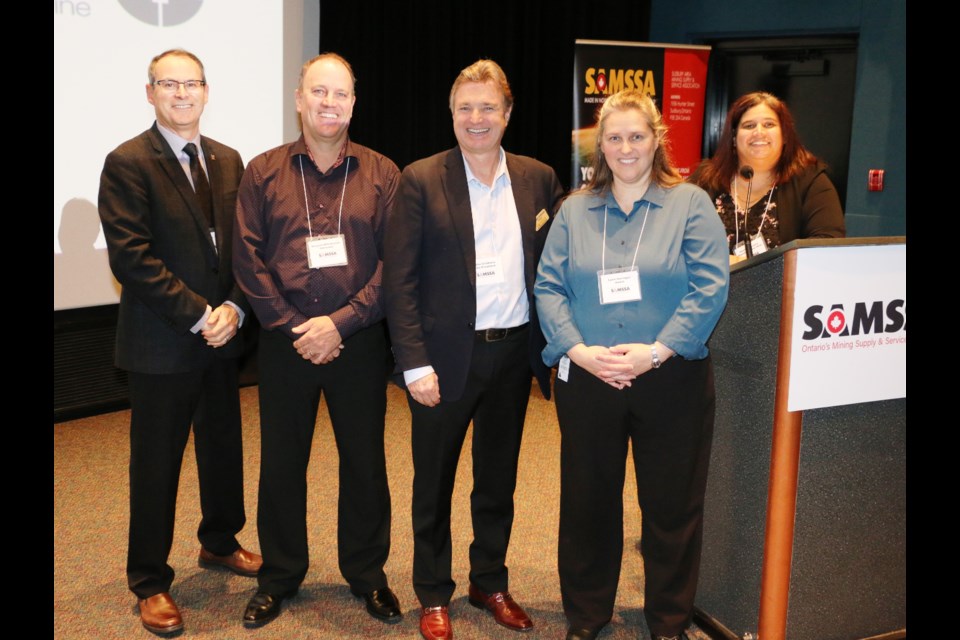It is going to take imagination, better communications and some good listening skills for the mining industry to attract and retain enough workers skilled in data-driven and digital technology.
Those were some of the comments during a recent panel discussion held in Sudbury at the annual general meeting of SAMSSA (Sudbury Area Mining Supply and Service Association).
The panel was made up of well-known experts in various sectors of mining. They included Michael Gribbons, vice-president of sales and marketing at Maestro Digital Mine; Lynn Iturregui, project management for mining at Hatch; Roy Slack, the president of CIM (Canadian Institute of Mining, Metallurgy and Petroleum) and Shayne Wisniewski, general manager of mining projects for Glencore’s Sudbury Integrated Nickel Operations.
Moderator Shannon Katary told the panel that companies are striving to understand what the workforce of the future will be like, what skills will be needed and what companies need to do to attract new talent.
“Given the competitive nature of the digital and data-driven skills required, how do you get it into the mining sector where the traditions and outdated reputation of mining is a bit of hindrance?” Katary asked the group.
Roy Slack, who said he talks to mining students at various universities, said the mining industry itself will have to take on the role of training for specific skills.
“What the students do at school is learn how to learn which means that we have to do training. And training has to become a core competency of all of our companies. And the companies that do the best training will get the best people and will retain the best people,” Slack told the meeting.
“And there are specialty groups out there, like NORCAT – full disclosure I’m a board member – but we’re not biased. But we do have to take on responsibility of training, as companies. It is as simple as that,” said Slack.
Lynn Iturregui said the industry needs to listen more, to learn and collaborate with next generation of workers.
“So one of the other things to realize is that – equal to training – we have to be willing to listen. The next generation coming up have ideas. They might not have them in our industry. or the space where we’re working, but we have to equally work to learn from them. Learn what is coming next; learn how that might play in our industry; share our experience and collaborate together,” she told the audience.
“That includes not just the young people coming through but people already on our staff. They’re out in their personal lives doing things differently and playing with technology and introducing that stuff so it is one of the things that can be harder, as the grey hair develops we like to talk about the young whipper-snappers and all the good fun things, but it is amazing what the next generation is doing now.”
Iturregui said it is just a matter of learning how to leverage those new skills to add value to the mining industry.
Shayne Wisniewski said the industry needs to do a better job of communicating with secondary schools, colleges and universities to explain what mining is about and what changes are in the works.
“The industry is changing. We’re getting rid of diesel. In my opinion, we’ll try and get rid of drilling and blasting for more efficient ways. We will try and make mining more continuous. It’s exciting,” he told the audience.
“We are going to be competing for AI people (artificial intelligence) so we have to figure out how to say what our industry is, talk about how we are stewards of the environmental, because I believe the big mining companies are and most have proven track records.” Wisniewski continued.
Michael Gribbons said he agreed with all the points presented by the other panelists but added there is a need to break down gender and cultural barriers.
“I would like to say we need to remove our biases. And these are our biases about people. We have to look outside of our industry and if I just look at this room right here I would think this equally represents mining in general,” said Gribbons.
“So I am not trying to say there should be any quotas for anything but we need to be looking outside our industry; we need to be looking at adding more women, more cultures, more diversity in our workforce. I think that’s the only way of moving forward,” he added.
As that portion of the discussion was wrapping up, Slack mentioned that CIM is working with Sudbury’s Science North to put together a national science exhibition that will outline how mining has become a sustainable, environmentally-responsible and high-tech industry.


